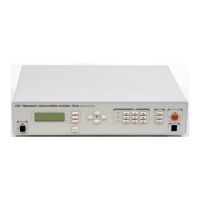5.4.3 Home Search
Home search is a specific motion routine that is useful for most types
of applications. Its goal is to find a specific point in travel relative to
the mounting base of the motion device very accurately and
repeatable. The need for this absolute reference point is twofold. First,
in many applications it is important to know the exact position in
space, even after a power-off cycle. Secondly, to protect the motion
device from hitting a travel obstruction set by the application (or its
own travel limits), the controller uses programmable software limits.
To be efficient though, the software limits must be placed accurately
in space before running the application.
To achieve this precise position referencing, the ESP300 motion
control system executes a unique sequence of moves.
First, lets look at the hardware required to determine the position of a
motion device. The most common (and the one supported by the
ESP300) are incremental encoders. By definition, these are encoders
that can tell only relative moves, not absolute position. The controller
keeps track of position by incrementing or decrementing a dedicated
counter according to the information received from the encoder. Since
there is no absolute position information, position "zero" is where the
controller was powered on (and the position counter reset).
To determine an absolute position, the controller must find a "switch"
that is unique to the entire travel, called a home switch or origin
switch. An important requisition is that this switch must be located
with the same accuracy as the encoder pulses.
If the motion device is using a linear scale as position encoder, the
home switch is usually placed on the same scale and read with the
same accuracy.
If, on the other hand, a rotary encoder is used, the problem becomes
more complicated. To have the same accuracy, a mark on the encoder
disk could be used (called index pulse) but because it repeats itself
every revolution, it does not define a unique point over the entire
travel.
An origin switch, on the other hand, placed in the travel of the motion
device is unique but not accurate (repeatable) enough. The solution is
to use both, following a search algorithm.
A home switch (
Figure 5.22) separates the entire travel in two areas:
one for which it has a high level and one for which is low. The most
important part of it is the transition between the two areas. Also,
looking at the origin switch level, the controller knows on which side
of the transition it currently is and which way to move to find it.
5-20 Section 5 – Motion Control Tutorial

